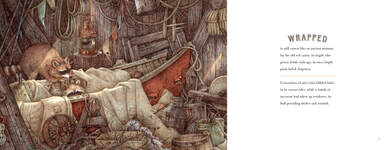By Kathryn Will, Michelle Ladd, and Calli LeachOur lives are full of many days, weeks, months, and seasons as the years stack up one after the other. Books can support children making connections to these patterns in their lives and developing connections to their families and the natural world around them. We have created a text set capturing the cyclical nature of time throughout our lives that invites children to lean into rich vocabulary, and the use of literary elements such as personification and metaphorical thinking as they develop their understanding of change over time. Teachers can easily deepen and extend the texts in various ways and we have gathered a few to get you started. This story examines the ties connecting us to our ancestors as it explores the relationship of a grandfather with his granddaughter, Emilia. One morning she finds a walnut on her nightstand, and it is the beginning of learning about the roots of her family’s story as time cycles through seasons and years. Grandpa teaches Emilia how to plant and nurture the seed as it grows, connecting her to those before her. Through this process Emilia discovers how the cycle of life is similar for nature and humans, and how the smallest of seeds can grow into a strong, healthy tree. Although her grandfather dies in the text, she is comforted by her connection to him and her ancestors through the burgeoning life of her own walnut tree. Felicita Sala’s illustrations are warm and inviting and capture the powerful emotions in the book. You may explore more about her work and illustrative process on her website. This video is another resource that allows children to watch a time-lapsed growth of a walnut: Told through the canoe’s perspective, the rich, beautiful, and descriptive language of this text takes the reader on a journey over a lifetime and beyond. First, throughout the life of a young boy who grows in skill and body through adventures outdoors in the canoe. He carefully wraps the canoe up for storage when he leaves to serve in the war, but does not return. After many years of storage (with plenty of wildland visitors over the years), the canoe hears the boathouse door creak open and the book ends with a young boy and his dad beginning the restoration process. Throughout the book, the reader experiences change over time of both people and their belongings as they grow older. Children will see how someone’s forgotten possessions can become another’s treasure. After reading the book, children might consider family heirlooms they have in their house, the people who had them before, and what was happening during the historical periods of the life of the object. This will allow them to make connections between the book and their lives as they ponder item representation and the values that they may hold. An interview with Anne Yvonne Gilbert is another resource that can give children additional information about her writing and illustrating processes. “Children are swept away on Mother Winter's long coattails” and are taken on a magical journey as they explore the wonders of the winter season. Throughout the book, Carroll incorporates metaphorical language in the rich poetic text. Readers are invited to explore the qualities of life winter brings while imagining a walk in the outdoors. If you are interested in learning about how James Christopher Carroll created the book, check out the video below. After reading the book, reread the text, pulling out the rich descriptions of winter as a class. Then, with consideration of the current season, go out for a walk, asking students to collect observations and noticings. Share these, thinking about the ways you might add descriptors and specificity to the collection. Use this rich word back to write a seasonal poem or a class book. The 2023 Notable Children’s Books in Language Arts Committee (NCBLA), read, reviewed, and discussed 651 books of various genres written for K-8 children in the past year. These works of poetry and prose were analyzed using the charge of the committee that asked us to consider the following when choosing the top 30 texts for grades K-8: 1. Appealing format, 2. Enduring quality, 3. Exemplary quality for their genre, and 4. Meeting one or more of the following: a. Use of language: play on words, word origins, history of language b. Uniqueness in use of language or style c. Invitation of child response or engagement We are really excited about the 2023 NCBLA list and hope you are too! Committee members: Kathryn Will, Chair, University of Maine Farmington Patrick Andrus, Eden Prairie School District, Minnesota Dorian Harrison, Ohio State University at Newark Joyce Herbeck, Montana State University Laura Hudock, Framingham State University, Massachusetts Lynette Smith, Walden University, Pennsylvania Fran Wilson, Madeira Elementary School, Ohio Kathryn Will is an Associate Professor of Literacy at the University of Maine Farmington (@KWsLitCrew). She is passionate about sharing the power of children's literature with her students, including the two listed below who assisted in the creation of this post and supported her work as the Chair of the 2023 NCBLA committee. Michelle Ladd is a preservice teacher at the University of Maine at Farmington. She is a nontraditional student and a mother to three young children. She hopes to one day inspire creativity and foster individuality in a PreK-3rd grade classroom. Calli Leach is a preservice teacher at the University of Maine at Farmington. She is passionate about helping her future students develop a love for reading and writing, as well as being a 4-H volunteer for the state of Maine. |
Authors:
|
CLA
About CLA
|
Journal of Children's Literature
Write for JCL
|
ResourcesCLA-sponsored NCTE Position Statements
|
Members-Only Content
CLA Video Library
|
© COPYRIGHT 2018.
ALL RIGHTS RESERVED |







 RSS Feed
RSS Feed